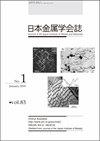无容器法制备Fe-Cu非混相合金的显微组织及凝固过程
IF 0.4
4区 材料科学
Q4 METALLURGY & METALLURGICAL ENGINEERING
引用次数: 9
摘要
非混相合金在重力作用下通常发生液相分离。滴管和电磁悬浮工艺是无容器工艺的类型,无需使用容器即可实现凝固熔体。这将避免由容器壁引起的异质神经形核,从而获得过冷条件。用上述方法研究了熔体的过冷凝固和亚稳相的形成。Fe︲Cu二元合金中存在亚稳混相间隙;然而,在广泛的组成范围内,亚稳相的形成,用滴管法从来没有报道过。在本研究中,我们使用自由落体长度为2的落管装置获得了Fe︲Cu二元合金样品。5米和一个电磁悬浮装置。此外,我们旨在研究基于过冷凝固的Fe︲Cu二元合金的无容器工艺的显微组织形成的有效性。SEM和EDS分析结果表明:Fe - 25和Fe - 25 Cu - 75的主液相和Fe - 50 Cu - 50的两层或三层结构的颗粒样品中,Fe - 25 Cu - 25和Fe - 25 Cu - 75颗粒样品的小液相Fe或Cu分散在基体中。特别是随着冷却速率的降低,所有样品都表现出由亚稳混相间隙和Fe相枝晶生长引起的相分离。本文章由计算机程序翻译,如有差异,请以英文原文为准。
Microstructure and solidification process of Fe-Cu immiscible alloy by using containerless process
Liquid phase separation usually occurs in immiscible alloys under gravity. The drop tube and electromagnetic levitation pro - cesses, which are types of containerless processes, enable solidification melt without using a container. This would avoid heteroge neous nucleation induced by the container walls, thus obtaining undercooling conditions. The abovementioned processes have been used to study the undercooling solidification and metastable phase formation of the melt. Metastable miscibility gap is observed in the Fe ︲ Cu binary alloy; however, metastable phase formation in the wide composition range used by the drop tube process has never been reported. In this study, we obtained samples of Fe ︲ Cu binary alloy using a drop tube apparatus with a free fall length of 2 . 5 m and an electromagnetic levitation apparatus. In addition, we aimed to examine the effectiveness of the containerless process for microstructure formation of the Fe ︲ Cu binary alloy based on undercooling solidification. The results of the SEM and EDS analyses showed that the minor liquid phase, Fe or Cu, finely dispersed in the matrix of the major liquid phase of Fe 75 Cu 25 and Fe 25 Cu 75 particle samples, and the two or three layer structure of Fe 50 Cu 50 particle samples. In particular, all the samples exhibited a phase separation caused by the metastable miscibility gap and the dendrite growth of Fe phase with the decrease of the cooling rate.
求助全文
通过发布文献求助,成功后即可免费获取论文全文。
去求助
来源期刊

Journal of The Japan Institute of Metals
工程技术-冶金工程
CiteScore
0.70
自引率
0.00%
发文量
27
审稿时长
6-12 weeks
期刊介绍:
Information not localized
 求助内容:
求助内容: 应助结果提醒方式:
应助结果提醒方式:


